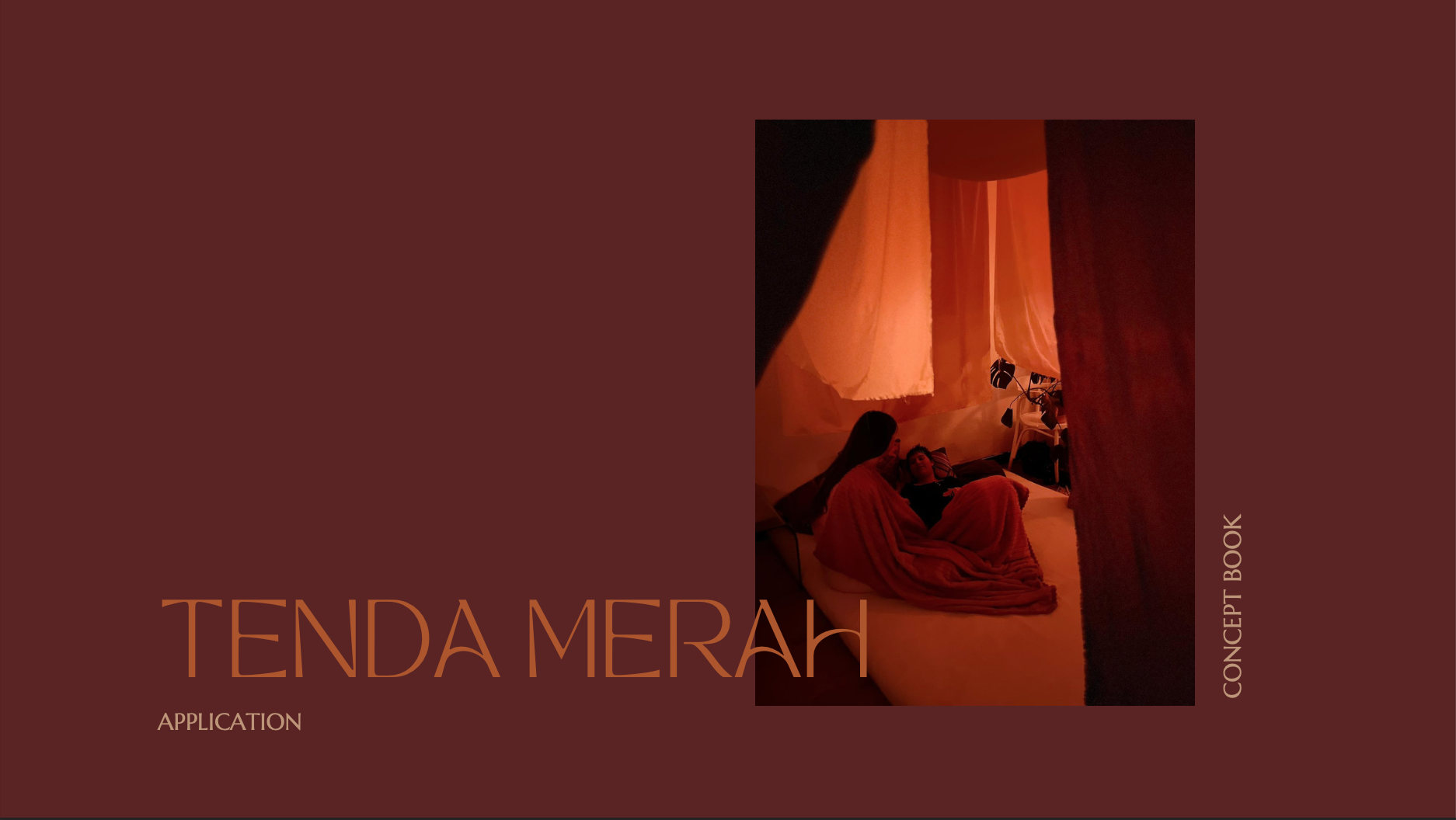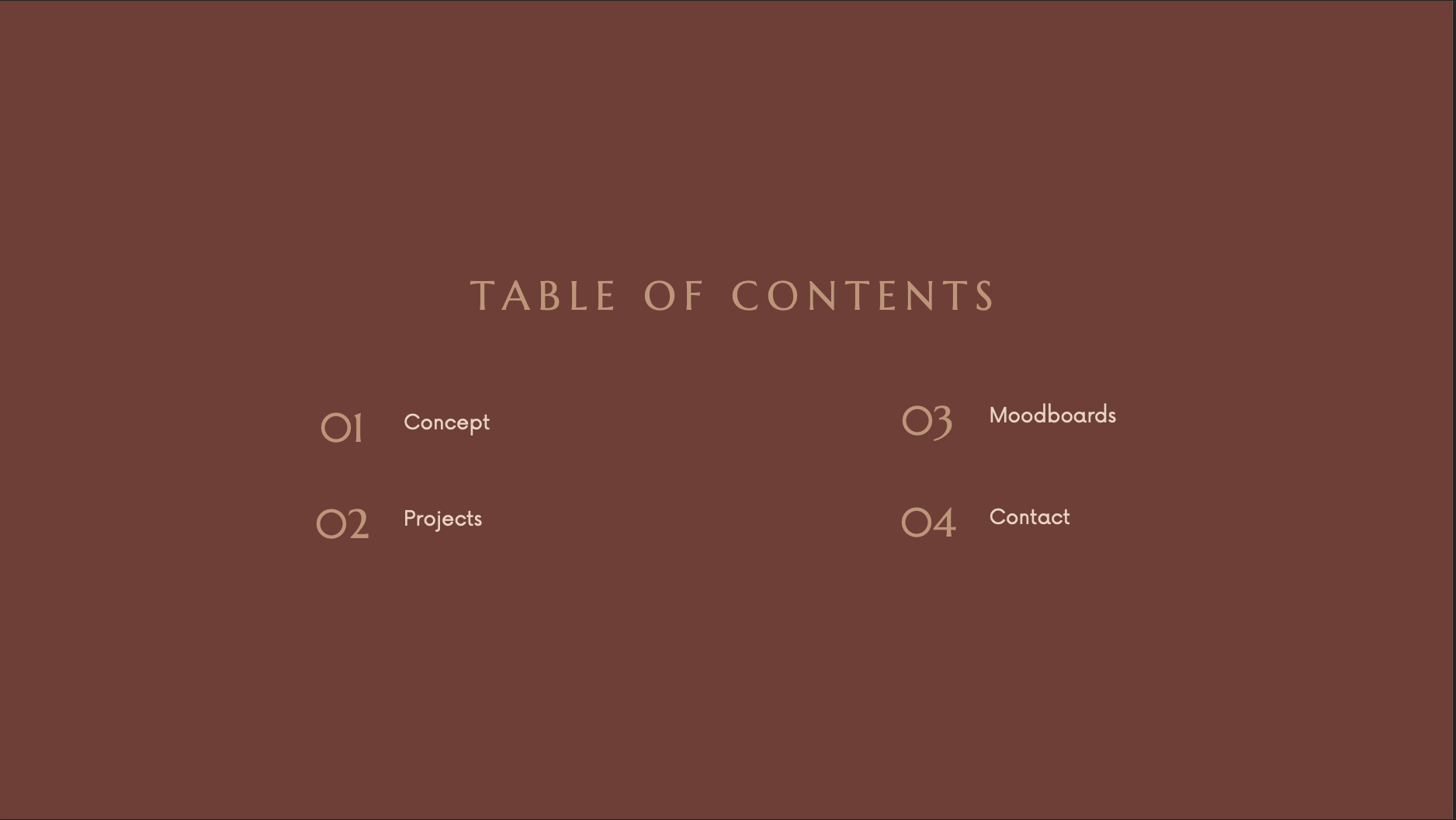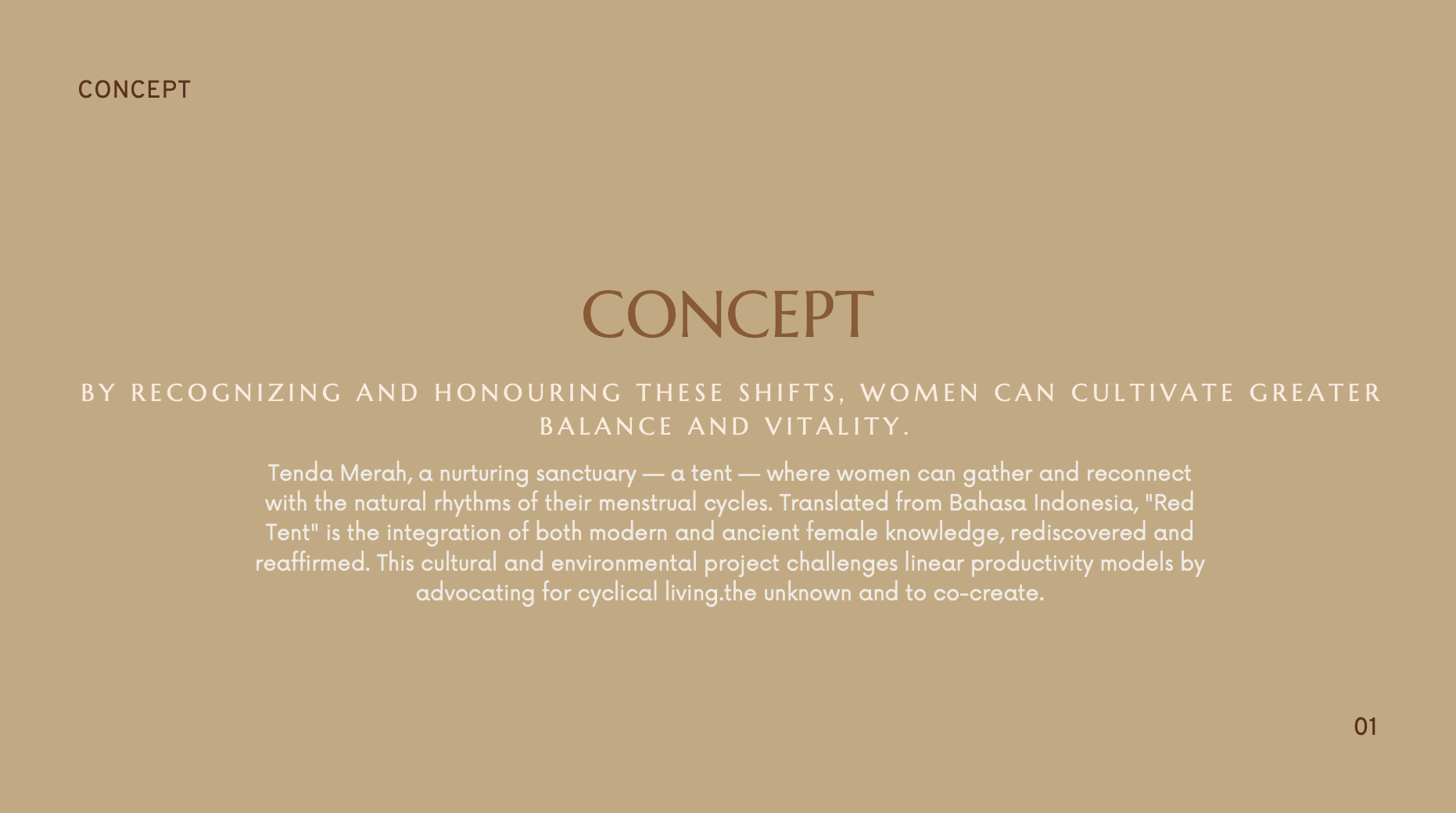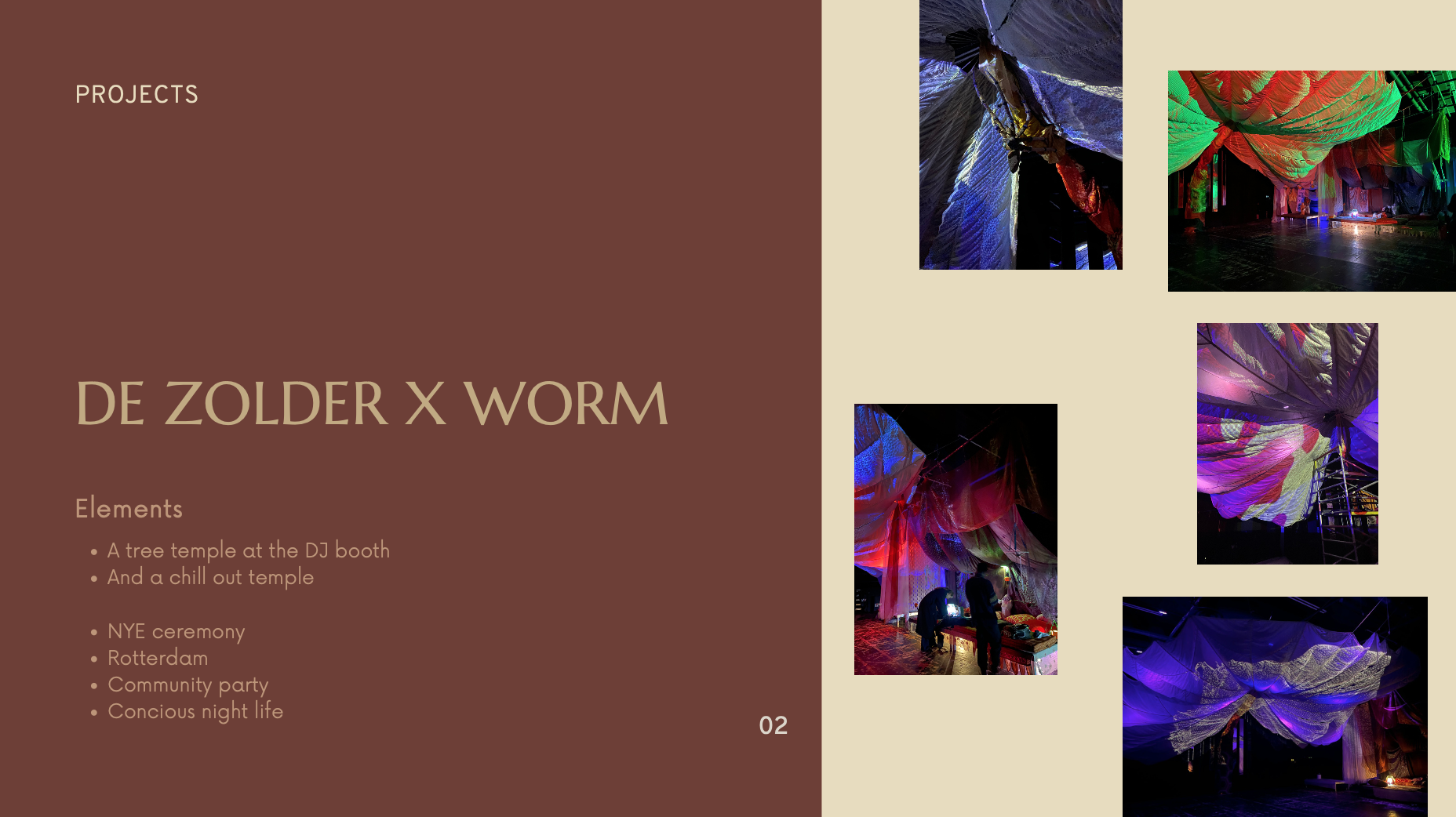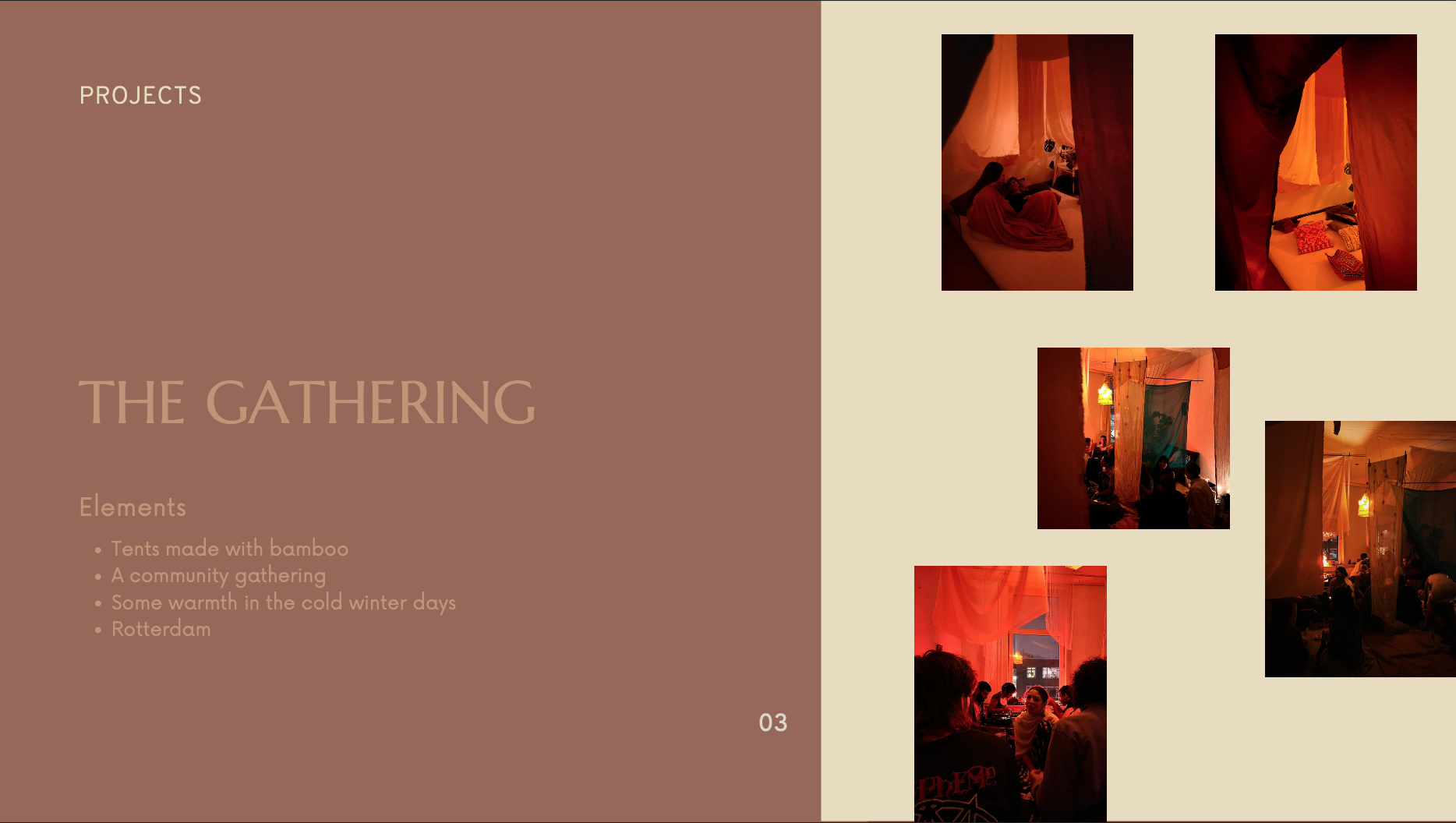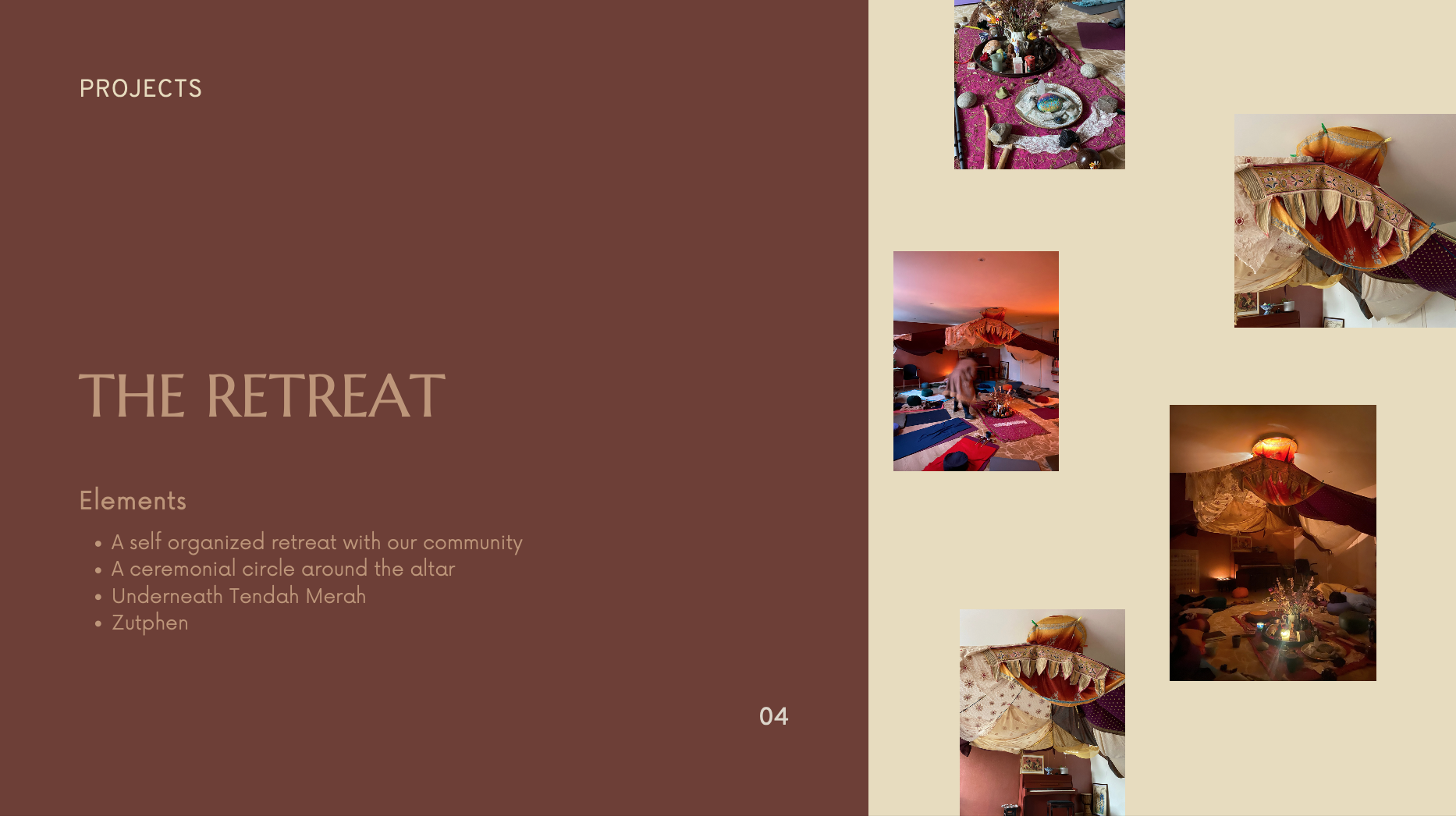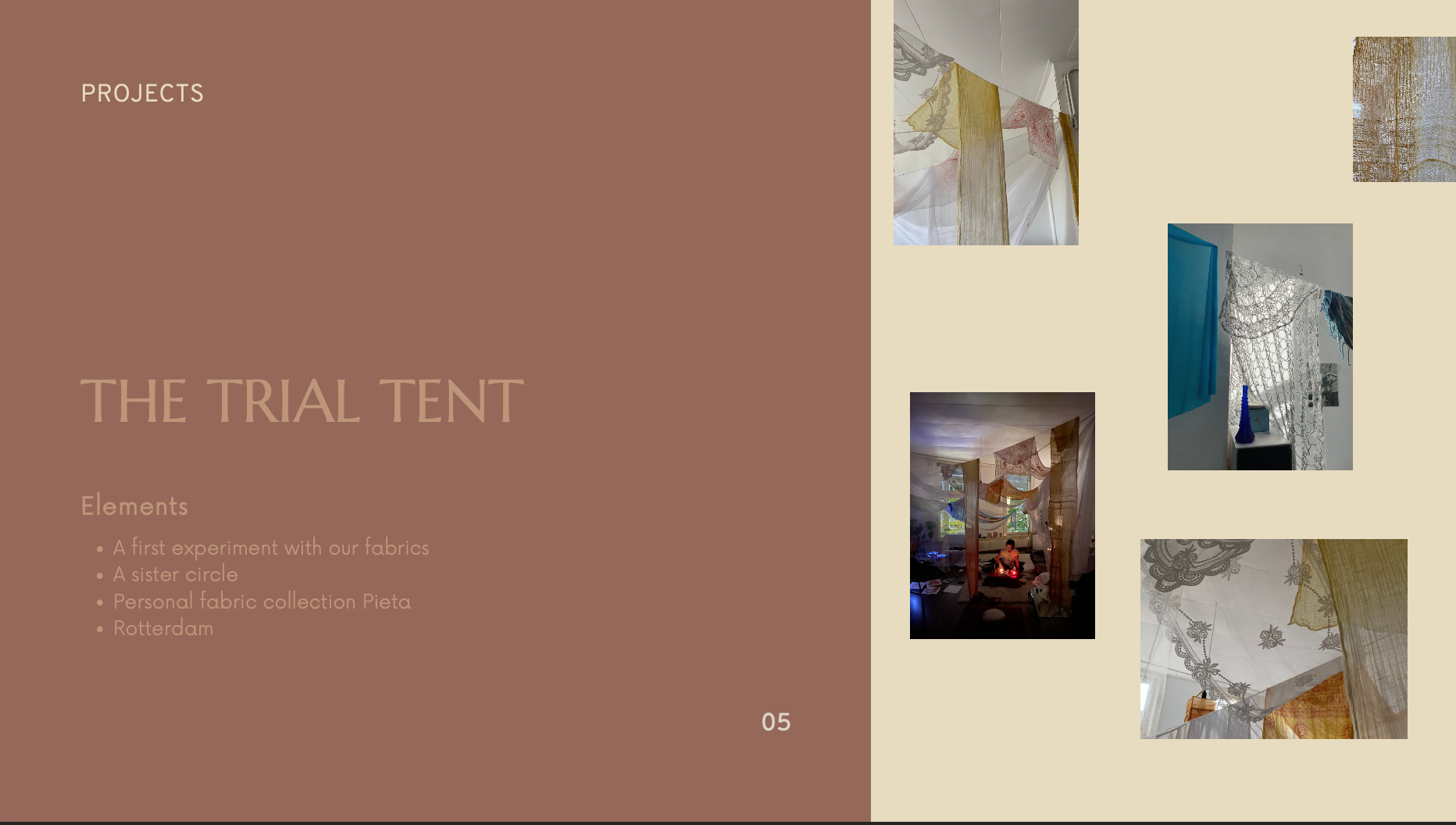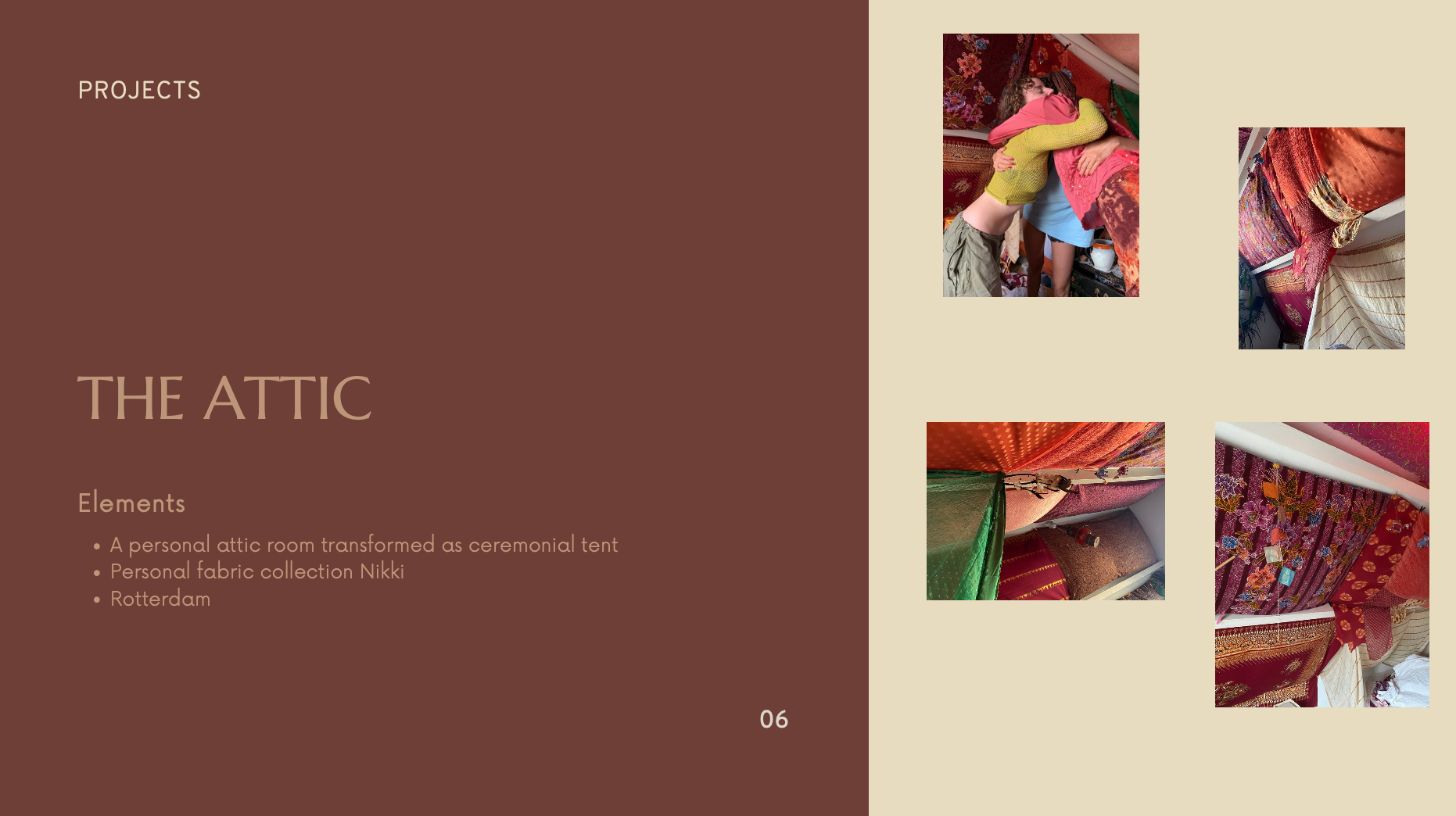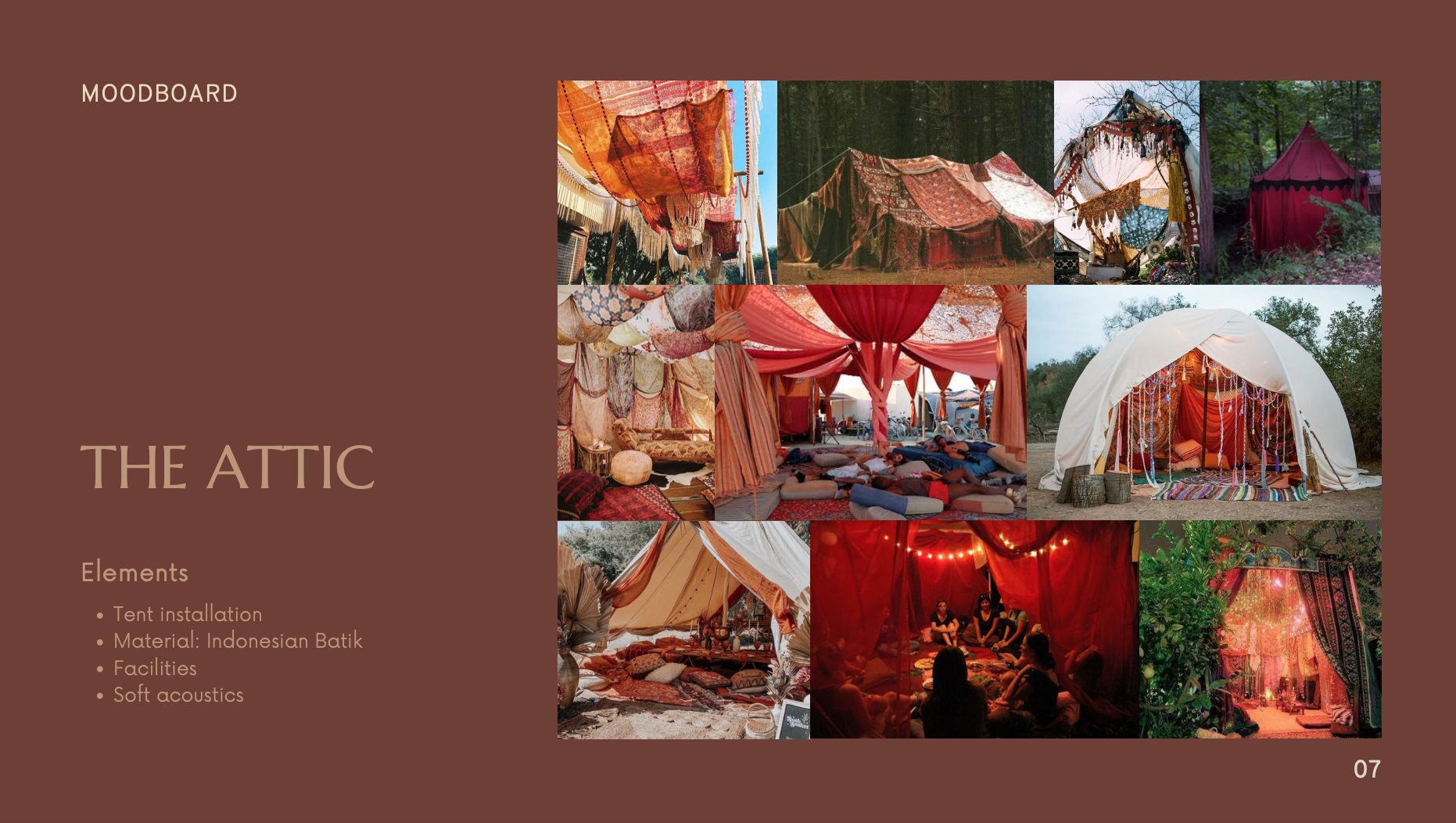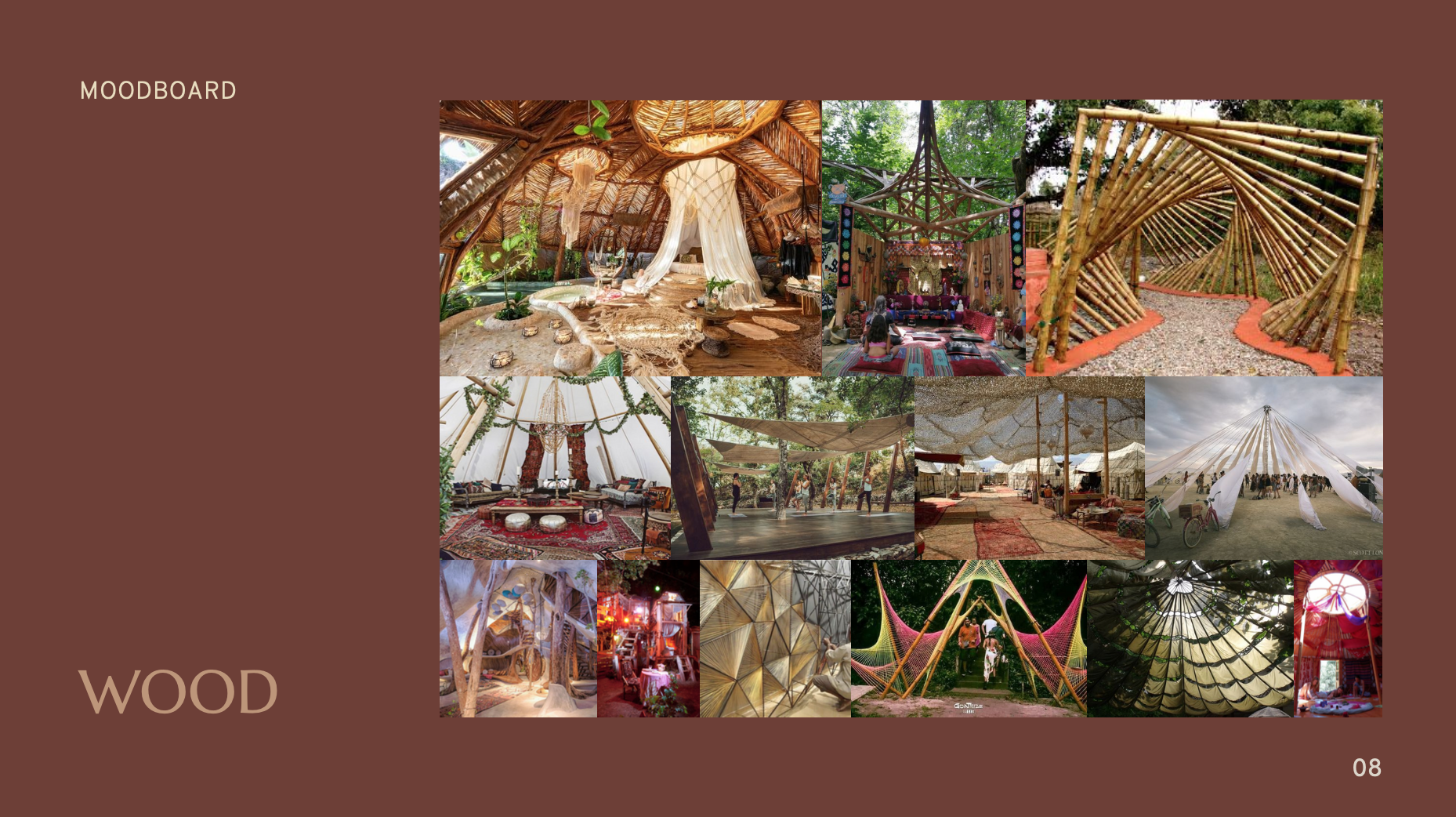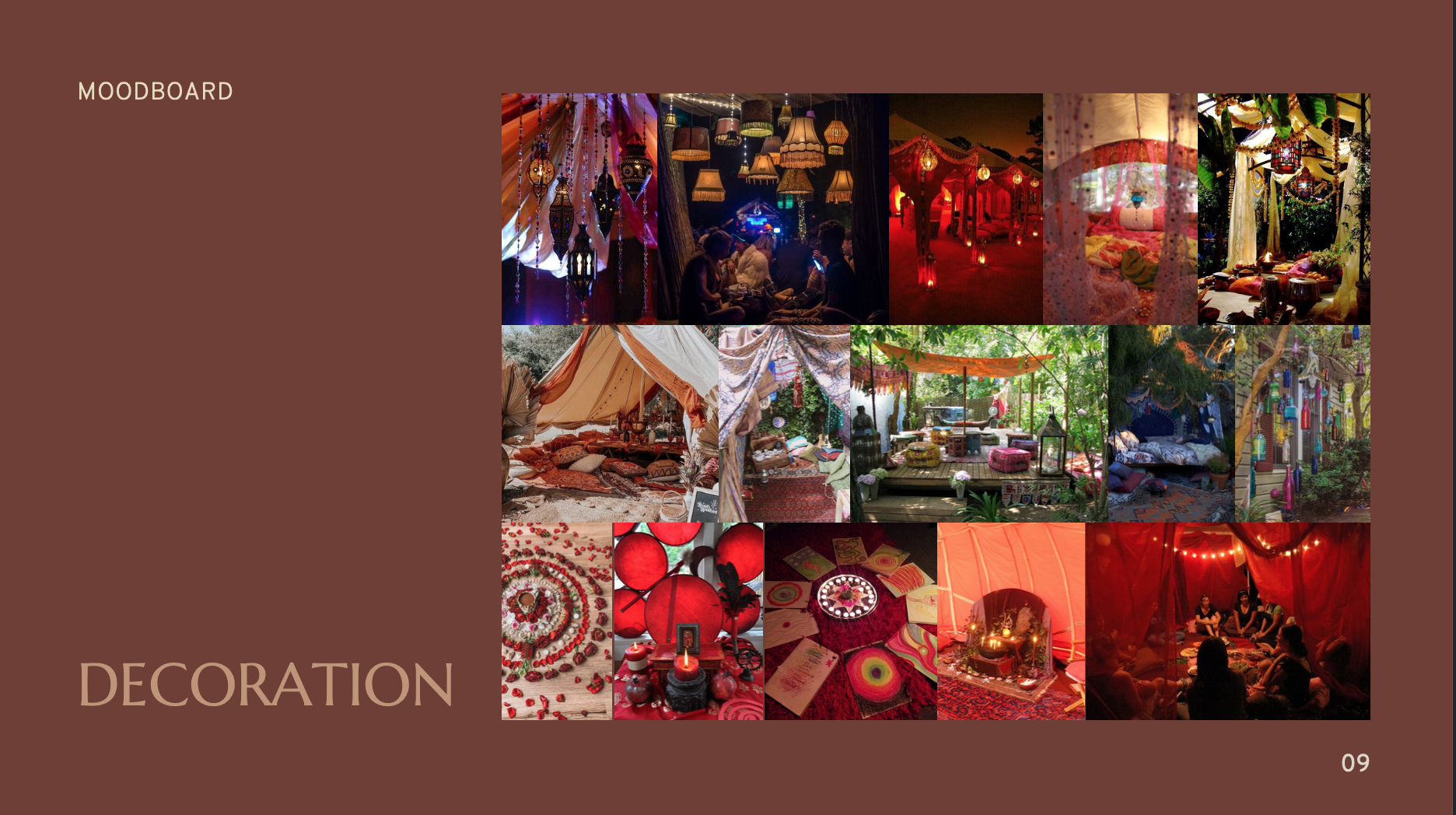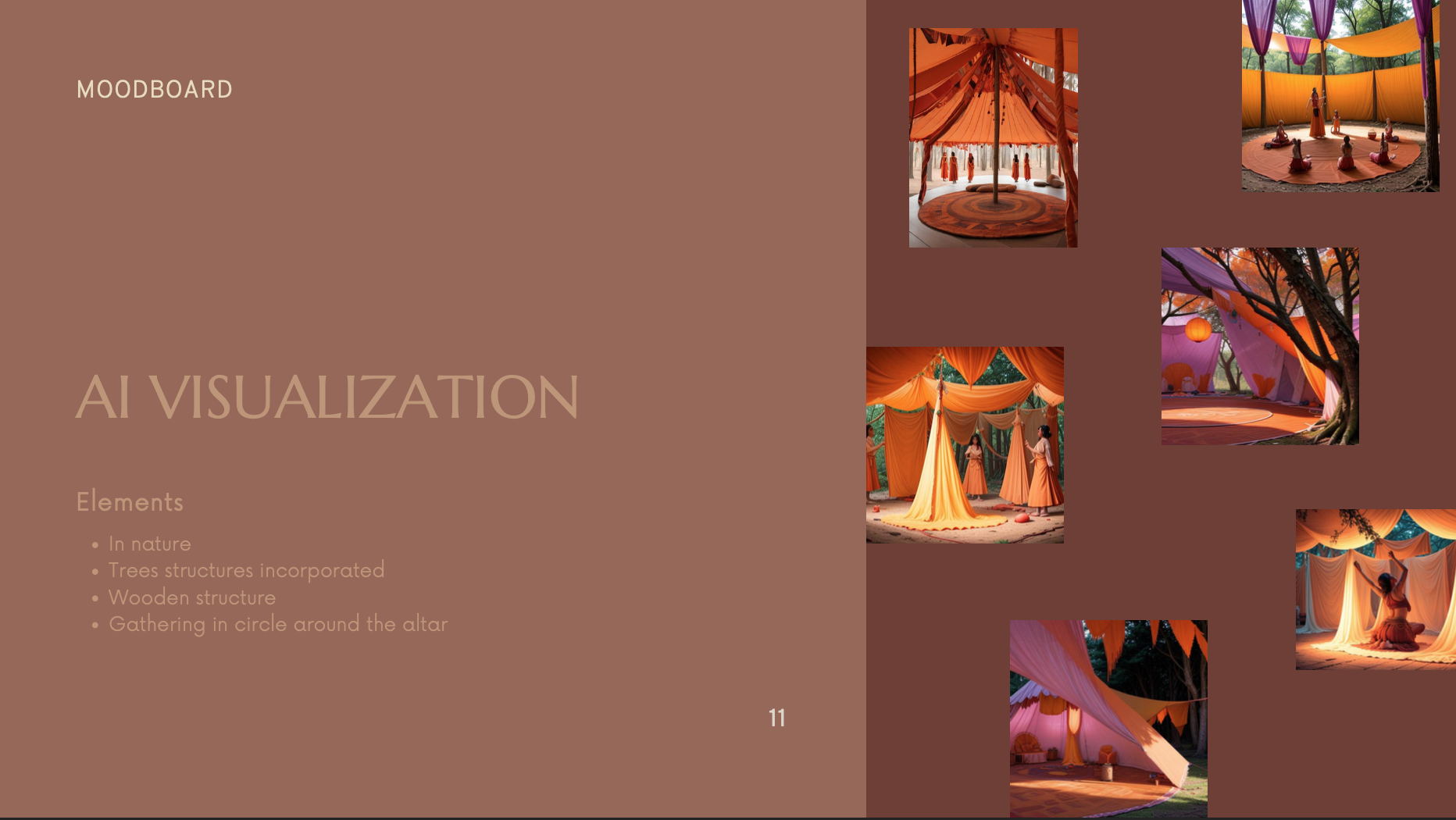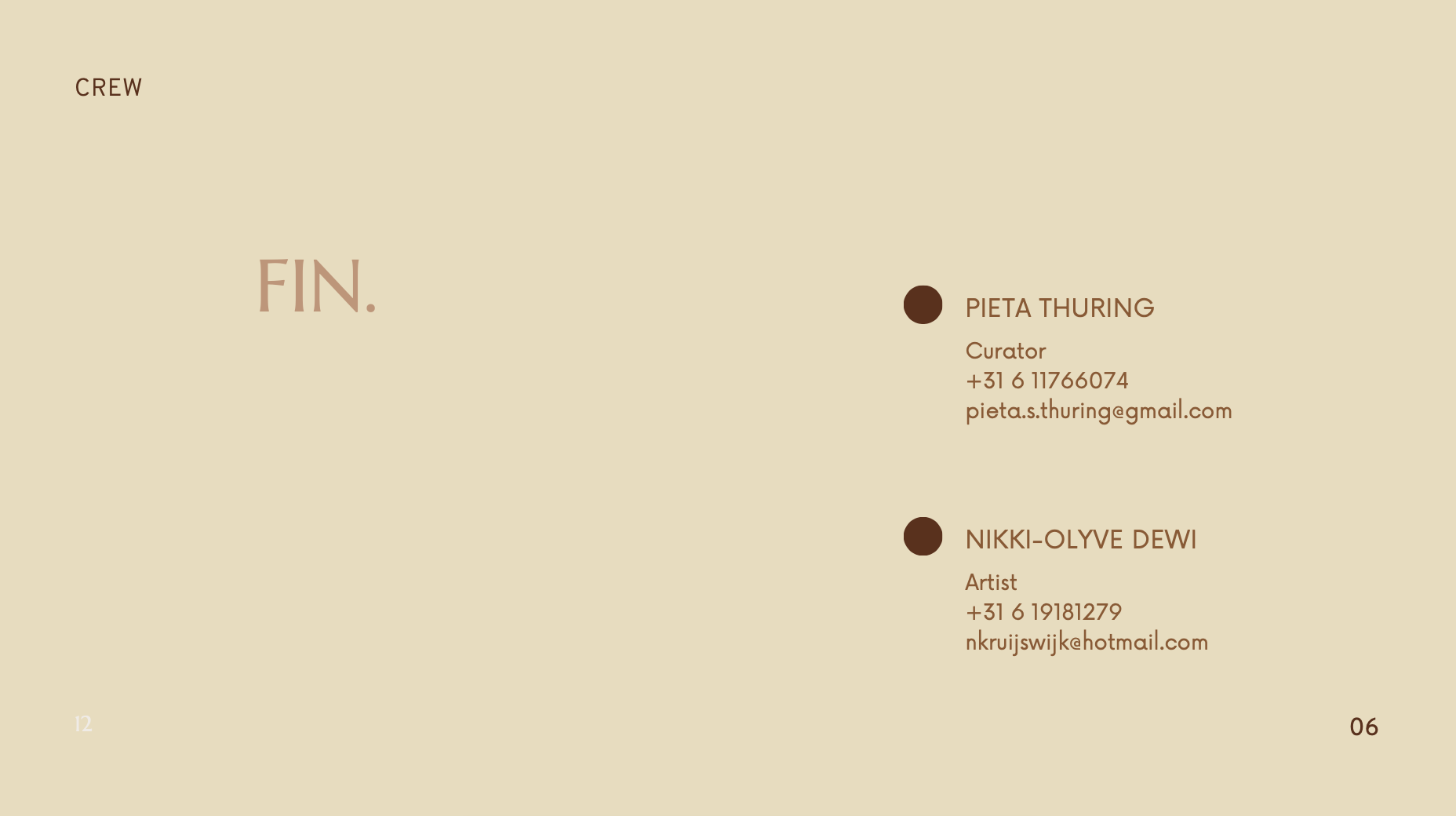Regaining a sense of belonging
Tenda Merah
Reclaiming the Rhythms of the Feminine Body
We aim to create a nurturing sanctuary—a tent—where women can come together to honor and embrace the natural rhythms of their menstrual cycles. This space will serve as a comforting, ceremonial environment for reflection, sharing wisdom, and fostering healing, recognizing menstruation as a vital part of the larger cycles of life.
Netherlands
Local
Rotterdam
Zutphen
Zutphen
It addresses urban-rural linkages
It refers to other types of transformations (soft investment)
Prototype level
No
No
As an individual
Tenda Merah is a sanctuary where women can reconnect with the natural rhythms of their menstrual cycles. Meaning "Red Tent" in Bahasa Indonesia, it blends ancient wisdom with modern understanding, reclaiming cyclical living in a world dominated by linear productivity. The modern 24-hour framework is built around the male hormonal cycle, often leaving women out of sync, leading to burnout and imbalances. In contrast, the female body follows a 28-day cycle, with energy shifts that affect cognition, emotions, and well-being. Ignoring these rhythms causes exhaustion, while embracing them fosters balance.
Examining menstruation in historical and religious contexts reveals a complex web of perspectives. In ancient societies—like the Maya—menstruation was seen as a sacred, communal experience, reinforcing bonds between women and nature. In contrast, religious influences and modern western structures often suppress or medicalize menstruation, treating it as an inconvenience rather than a guide for life. This suppression reflects a broader pattern in patriarchal and capitalist structures, where traditionally female domains are marginalized—economically, culturally, and intellectually.
Tenda Merah revives these traditions, offering a space for storytelling, rituals, and shared wisdom. Each phase of the cycle calls for different needs—rest, renewal, energy, and reflection. By honoring these rhythms, women can cultivate greater vitality and resilience.
Rooted in the values of the New European Bauhaus, Tenda Merah integrates aesthetics, sustainability, and inclusivity. In the fast-paced urban landscape of the Netherlands, where communal spaces are disappearing, it offers a tangible, shared environment for women to gather and create meaningful connections. While still in its early stages, Tenda Merah is growing through small, intimate events with the long-term vision of evolving into a sustainable space for women’s health, cultural preservation, and community-building.
Examining menstruation in historical and religious contexts reveals a complex web of perspectives. In ancient societies—like the Maya—menstruation was seen as a sacred, communal experience, reinforcing bonds between women and nature. In contrast, religious influences and modern western structures often suppress or medicalize menstruation, treating it as an inconvenience rather than a guide for life. This suppression reflects a broader pattern in patriarchal and capitalist structures, where traditionally female domains are marginalized—economically, culturally, and intellectually.
Tenda Merah revives these traditions, offering a space for storytelling, rituals, and shared wisdom. Each phase of the cycle calls for different needs—rest, renewal, energy, and reflection. By honoring these rhythms, women can cultivate greater vitality and resilience.
Rooted in the values of the New European Bauhaus, Tenda Merah integrates aesthetics, sustainability, and inclusivity. In the fast-paced urban landscape of the Netherlands, where communal spaces are disappearing, it offers a tangible, shared environment for women to gather and create meaningful connections. While still in its early stages, Tenda Merah is growing through small, intimate events with the long-term vision of evolving into a sustainable space for women’s health, cultural preservation, and community-building.
Female Empowerment and Sovereignty
Cyclical Living & Menstrual Awareness
Community and Belonging
Cultural and Societal Change
Ritual & Ancestral Wisdom
Tenda Merah is built with a deep commitment to sustainability. Through this project, we explore how to reconnect with the Earth in a meaningful way, recognizing its value beyond a resource to be used. We seek to balance economic, ecological, and social value creation.
Ecologically, Tenda Merah engages with local ecosystems, treating the land as an active partner rather than a resource to extract from. By working with natural cycles, we integrate regenerative practices by having zero waste and by considering the full life cycle of the objects and materials we use. We also recognize that materials hold their own histories and transformations, encouraging a deeper awareness of our relationship with the material world.
The project embraces a mobile, adaptable structure inspired by ancient nomadic ways of living, minimizing reliance on permanent infrastructure and reducing environmental impact. By reusing fabrics, repurposing materials, and integrating circular design principles, we ensure that nothing is discarded unnecessarily. This lowers our ecological footprint while allowing Tenda Merah to move across different landscapes, fostering connections between communities while leaving minimal traces behind.
Prioritizing handpicked materials that are locally sourced, we carefully choose the fibers of our tent. This project supports community-centered practices while preserving traditional textile techniques and fostering a deeper connection to cultural heritage. Natural fibers like linen, cotton, and hemp, along with plant-based dyes, ensure that each fabric carries a story while remaining sustainable.
By integrating these practices, Tenda Merah offers a sustainable model that balances environmental, cultural, and social aspects. It provides a concrete example of how design can foster community and sustainability in a modern context while honoring the wisdom of the past.
Ecologically, Tenda Merah engages with local ecosystems, treating the land as an active partner rather than a resource to extract from. By working with natural cycles, we integrate regenerative practices by having zero waste and by considering the full life cycle of the objects and materials we use. We also recognize that materials hold their own histories and transformations, encouraging a deeper awareness of our relationship with the material world.
The project embraces a mobile, adaptable structure inspired by ancient nomadic ways of living, minimizing reliance on permanent infrastructure and reducing environmental impact. By reusing fabrics, repurposing materials, and integrating circular design principles, we ensure that nothing is discarded unnecessarily. This lowers our ecological footprint while allowing Tenda Merah to move across different landscapes, fostering connections between communities while leaving minimal traces behind.
Prioritizing handpicked materials that are locally sourced, we carefully choose the fibers of our tent. This project supports community-centered practices while preserving traditional textile techniques and fostering a deeper connection to cultural heritage. Natural fibers like linen, cotton, and hemp, along with plant-based dyes, ensure that each fabric carries a story while remaining sustainable.
By integrating these practices, Tenda Merah offers a sustainable model that balances environmental, cultural, and social aspects. It provides a concrete example of how design can foster community and sustainability in a modern context while honoring the wisdom of the past.
Rooted in Indonesian-Dutch heritage, we carefully select threads woven by the hands of women, choosing the fibres for our tent. The symbols and motifs in Ikat weaving and Batik dyeing play a significant role in storytelling, infusing immense personal and collective socio-cultural significance into Tenda Merah. The space transforms into a haven, offering comfort and a space for sharing stories, all intertwined with the richness of our ancestral traditions. The natural flowing structure evokes the feeling of a living, breathing space, reinforcing the idea that the tent is not just a shelter but an organic environment that holds and nurtures those within. Another idea we are exploring are smaller tents within a larger tent, or closable curtains where people can retreat while still remaining connected to the whole.
The interior will also feature art pieces and decorations from local artists, as well as reading table with educational books, essays and other resources relating to menstruation, cyclical living etc. This ensures that information sharing is integrated into the aesthetic and sensory experience of the space.
Beyond its design, Tenda Merah revives rituals of gathering and storytelling, offering a setting for deep listening, shared wisdom, and personal reflection. In a time when many urban spaces prioritize commerce over connection, this project creates an intimate alternative where women can feel seen, supported, and empowered.
By integrating thoughtful design with cultural significance, Tenda Merah exemplifies how aesthetics can contribute to experience of a ceremony. It demonstrates that design is not only about visual appeal but also about creating spaces that cultivate connection, presence, and shared experiences.
The interior will also feature art pieces and decorations from local artists, as well as reading table with educational books, essays and other resources relating to menstruation, cyclical living etc. This ensures that information sharing is integrated into the aesthetic and sensory experience of the space.
Beyond its design, Tenda Merah revives rituals of gathering and storytelling, offering a setting for deep listening, shared wisdom, and personal reflection. In a time when many urban spaces prioritize commerce over connection, this project creates an intimate alternative where women can feel seen, supported, and empowered.
By integrating thoughtful design with cultural significance, Tenda Merah exemplifies how aesthetics can contribute to experience of a ceremony. It demonstrates that design is not only about visual appeal but also about creating spaces that cultivate connection, presence, and shared experiences.
Tendah Merah is a gender-inclusive space that embraces diversity and creates room for difference. While we are all equal, equality does not mean sameness. Men are different from women, and cisgender women are different to transgender women. By creating space for these differences, we open the door to celebrating them. Tendah Merah is a place for women and people with wombs to come together, exchange knowledge, and support one another’s health and well-being within a patriarchal system. It is a sanctuary where individuality is honored, and community thrives. By reframing menstruation as a collective experience rather than a private matter, Tenda Merah reconnects it to cultural and social narratives that honour cyclical living.
The space welcomes writers, researchers, and professionals who embody cyclical ways of living to share their knowledge with younger generations, offering insights on integrating these principles into daily life. Through dialogue and storytelling, knowledge can be exchanged in both practical and transformative ways.
Tenda Merah ensures accessibility on both physical and emotional levels. Its flowing structure, soft textiles and natural materials create a soothing atmosphere. Books, art, and storytelling elements present knowledge in multiple formats, so that learning can be accessible to diverse backgrounds.
Tenda Merah also addresses the decline of communal, non-commercial spaces, particularly in urban environments where traditional gathering places like churches have faded. By offering an alternative rooted in shared experiences and a deep respect for nature, it counters the isolating effects of individualism.
With inclusivity at its core, Tenda Merah fosters belonging, cultural exchange, and shared knowledge, serving as a living model for meaningful and regenerative community spaces.
The space welcomes writers, researchers, and professionals who embody cyclical ways of living to share their knowledge with younger generations, offering insights on integrating these principles into daily life. Through dialogue and storytelling, knowledge can be exchanged in both practical and transformative ways.
Tenda Merah ensures accessibility on both physical and emotional levels. Its flowing structure, soft textiles and natural materials create a soothing atmosphere. Books, art, and storytelling elements present knowledge in multiple formats, so that learning can be accessible to diverse backgrounds.
Tenda Merah also addresses the decline of communal, non-commercial spaces, particularly in urban environments where traditional gathering places like churches have faded. By offering an alternative rooted in shared experiences and a deep respect for nature, it counters the isolating effects of individualism.
With inclusivity at its core, Tenda Merah fosters belonging, cultural exchange, and shared knowledge, serving as a living model for meaningful and regenerative community spaces.
Tenda Merah has taken shape through conversations with women from all walks of life—students, professionals, mothers, and elders—who have expressed the need for a space where menstrual health and womanhood can be acknowledged without shame. Beyond being a place of refuge, it’s also about education. Understanding menstrual cycles, reproductive health, and overall well-being shouldn’t be limited to women; these conversations need to be part of daily life, in workplaces, schools, and homes and include men. A deeper understanding of menstrual health has far-reaching effects on society. When workplaces accommodate menstrual needs, productivity and well-being improve. When schools provide proper education, young people grow up informed rather than embarrassed or ashamed. By opening up the dialogue, we work toward breaking taboos and creating a culture where menstrual health is recognized and supported by everyone.
As the project continues to grow, women are actively encouraged to contribute ideas, rituals, and practices that enrich the collective experience. Additionally, we will also continue the dialogue with men. By prioritizing a bottom-up approach, the project ensures that it remains an authentic and evolving sanctuary—one that is by the community, for the community.
As the project continues to grow, women are actively encouraged to contribute ideas, rituals, and practices that enrich the collective experience. Additionally, we will also continue the dialogue with men. By prioritizing a bottom-up approach, the project ensures that it remains an authentic and evolving sanctuary—one that is by the community, for the community.
Tenda Merah has taken shape through the involvement of local women and artists, making sure it remains a space that truly reflects the needs of the community. Their input has been key in shaping the project into something meaningful, relevant, and alive.
From the start, it’s been clear that there’s a deep need for spaces where conversations about womanhood, natural cycles, and shared wisdom can unfold freely. These discussions have reinforced how important it is to create a space that is open, adaptable, and shaped by those who step into it. Women’s feedback has helped tailor the project to what feels right, while local artists have brought in creative energy, adding to the experience in ways that words alone can’t.
Right now, the focus is on building a strong foundation, especially among younger women (19–35), while also weaving in the knowledge and presence of older generations. The project is still growing, and while we haven’t yet connected with larger networks beyond the local level, there’s huge potential. We’re looking at ways to collaborate with other collectives, NGO’s and communities that share the similar vision—one that values empowerment, cultural traditions, and sustainability.
From the start, it’s been clear that there’s a deep need for spaces where conversations about womanhood, natural cycles, and shared wisdom can unfold freely. These discussions have reinforced how important it is to create a space that is open, adaptable, and shaped by those who step into it. Women’s feedback has helped tailor the project to what feels right, while local artists have brought in creative energy, adding to the experience in ways that words alone can’t.
Right now, the focus is on building a strong foundation, especially among younger women (19–35), while also weaving in the knowledge and presence of older generations. The project is still growing, and while we haven’t yet connected with larger networks beyond the local level, there’s huge potential. We’re looking at ways to collaborate with other collectives, NGO’s and communities that share the similar vision—one that values empowerment, cultural traditions, and sustainability.
The design and implementation of Tenda Merah draw from multiple disciplines, with each creator bringing their unique expertise. Nikki’s fine-arts background informs her dynamic, artistic approach, shaping the tent to respond to each location. She tailors the design to elements in the environment, such as trees or walls, bringing visual aesthetics to every installation. Pieta’s background in herbalism, business & creative media curates the space, weaving together intuition, symbolism, and sustainability.
One key concept is the integration of symbols that connect to time and natural cycles. A sundial or a representation of the four wind directions on the floor reinforces a sense of rhythm and connection to nature. The fabrics used—ikat and batik—carry deep traditions. In Indonesia, weaving is strictly a women’s craft, part of the feminine domain. Cloths are considered living entities with their own spirit. The weaving process follows the lunar cycle, with priests performing rituals before a new piece is created. These fabrics don’t just decorate the space; they are part of its energy, carrying ancestral wisdom and storytelling. Another design choice is linking the tent to tree branches, symbolizing the connection between our inner cycles and nature’s rhythms.
This multidisciplinary approach makes Tenda Merah more than a physical structure—it is a space that breathes, shaped by cultural traditions, artistic vision, and natural rhythms. Moving forward, we aim to collaborate with an architect to develop symbolic spatial elements—tent shapes reflecting the womb, spirals, or mandalas—further exploring themes of womanhood and cyclical life. Researching alternative natural materials could also expand sustainability, reinforcing Tenda Merah as a living, evolving entity that bridges tradition, intuition, and innovation.
One key concept is the integration of symbols that connect to time and natural cycles. A sundial or a representation of the four wind directions on the floor reinforces a sense of rhythm and connection to nature. The fabrics used—ikat and batik—carry deep traditions. In Indonesia, weaving is strictly a women’s craft, part of the feminine domain. Cloths are considered living entities with their own spirit. The weaving process follows the lunar cycle, with priests performing rituals before a new piece is created. These fabrics don’t just decorate the space; they are part of its energy, carrying ancestral wisdom and storytelling. Another design choice is linking the tent to tree branches, symbolizing the connection between our inner cycles and nature’s rhythms.
This multidisciplinary approach makes Tenda Merah more than a physical structure—it is a space that breathes, shaped by cultural traditions, artistic vision, and natural rhythms. Moving forward, we aim to collaborate with an architect to develop symbolic spatial elements—tent shapes reflecting the womb, spirals, or mandalas—further exploring themes of womanhood and cyclical life. Researching alternative natural materials could also expand sustainability, reinforcing Tenda Merah as a living, evolving entity that bridges tradition, intuition, and innovation.
Tenda Merah weaves ancient rituals, traditional knowledge, and modern research, bridging past and present ways of knowing. It’s a space where ceremonies—both big and small—connect us to ourselves, each other, and the land. Ritual isn’t just something we perform; it’s in the way we move, speak, and hold space with intention and care.
Reclaiming these ways is also an act of resistance. The European witch hunts (15th–18th centuries) violently suppressed female knowledge systems, targeting midwives, herbalists, and those practicing nature-aligned traditions. This erasure wasn’t just religious persecution—it severed people from the land, cyclical time, and collective care. The loss of communal healing and embodied wisdom left a void that modern individualism and scientific rationalism have never truly filled.
Today, wellness is often fragmented, commercialized, and medicalized, treating the body in isolation rather than as part of an interconnected whole. Tenda Merah offers an alternative: a living space where knowledge is preserved and exchanged through lived experience, not just textbooks or institutions. We integrate scientific research, Ayurveda, Traditional Chinese Medicine, and ancestral storytelling, empowering women to reclaim sovereignty over their bodies and make informed decisions.
Unlike conventional wellness models, which often exclude non-Western and intuitive knowledge, Tenda Merah fosters a holistic, community-centered approach. Through storytelling, dialogue, and shared rituals, we counter isolation and nurture a sense of belonging, agency, and connection. By honoring what was lost and creating space for it to thrive, Tenda Merah isn’t just about looking back—it’s about building something vital for today and the future.
Reclaiming these ways is also an act of resistance. The European witch hunts (15th–18th centuries) violently suppressed female knowledge systems, targeting midwives, herbalists, and those practicing nature-aligned traditions. This erasure wasn’t just religious persecution—it severed people from the land, cyclical time, and collective care. The loss of communal healing and embodied wisdom left a void that modern individualism and scientific rationalism have never truly filled.
Today, wellness is often fragmented, commercialized, and medicalized, treating the body in isolation rather than as part of an interconnected whole. Tenda Merah offers an alternative: a living space where knowledge is preserved and exchanged through lived experience, not just textbooks or institutions. We integrate scientific research, Ayurveda, Traditional Chinese Medicine, and ancestral storytelling, empowering women to reclaim sovereignty over their bodies and make informed decisions.
Unlike conventional wellness models, which often exclude non-Western and intuitive knowledge, Tenda Merah fosters a holistic, community-centered approach. Through storytelling, dialogue, and shared rituals, we counter isolation and nurture a sense of belonging, agency, and connection. By honoring what was lost and creating space for it to thrive, Tenda Merah isn’t just about looking back—it’s about building something vital for today and the future.
Tenda Merah is developed through an iterative and collaborative process that blends research, practice, and intuitive design. Our methodology is rooted in continuous learning, community engagement, and hands-on experimentation, ensuring the project remains dynamic and responsive.
We began and will continue with deep research into both historical and contemporary perspectives on menstruation, feminine wisdom, and cyclical living. This includes academic studies, traditional healing practices, and lived experiences. This project will include diverse knowledge streams, from scientific research to Ayurveda and Traditional Chinese Medicine, ensuring a holistic approach. Blending these research based practices, we bridge ancestral wisdom with modern insights, making them accessible and relevant today.
Collaboration is key, with Nikki and Pieta blending their Indische heritage and expertise to create a well-rounded space. Nikki, as art director, draws from her fine arts background to shape the visual elements, honouring intergenerational healing. Pieta, as curator, ensures everything—from textiles to rituals—flows together, weaving stories into a cohesive whole. As the project grows, we are looking to work closely with herbalists, researchers, and artists to co-create content, ceremonies, and discussions. Engaging with both medical professionals and holistic practitioners allows us to explore different healing modalities. This project will continue to seek input from all types of women who participate, valuing shared experiences as an essential source of knowledge. Considering this open approach, Tenda Merah becomes a living and evolving project that values inclusivity.
We began and will continue with deep research into both historical and contemporary perspectives on menstruation, feminine wisdom, and cyclical living. This includes academic studies, traditional healing practices, and lived experiences. This project will include diverse knowledge streams, from scientific research to Ayurveda and Traditional Chinese Medicine, ensuring a holistic approach. Blending these research based practices, we bridge ancestral wisdom with modern insights, making them accessible and relevant today.
Collaboration is key, with Nikki and Pieta blending their Indische heritage and expertise to create a well-rounded space. Nikki, as art director, draws from her fine arts background to shape the visual elements, honouring intergenerational healing. Pieta, as curator, ensures everything—from textiles to rituals—flows together, weaving stories into a cohesive whole. As the project grows, we are looking to work closely with herbalists, researchers, and artists to co-create content, ceremonies, and discussions. Engaging with both medical professionals and holistic practitioners allows us to explore different healing modalities. This project will continue to seek input from all types of women who participate, valuing shared experiences as an essential source of knowledge. Considering this open approach, Tenda Merah becomes a living and evolving project that values inclusivity.
Tenda Merah is designed to be fluid, adaptable, and transferable across locations, communities, and contexts. Its mobile nature allows it to be set up in diverse environments, whether in urban spaces, nature, or indoor settings, making it accessible to a broad range of people. This adaptability is essential—not just in a practical sense, but in how the space can evolve to meet the needs of different groups.
At its core, Tenda Merah is built on principles of inclusivity, empowerment, and cultural exchange. While currently centering on women (including queer and trans women) and those with wombs, we are looking at ways in which we can eventually include men into the conversation. This expansion would be done with care, ensuring that the essence of the space—one of safety, deep listening, and connection—remains intact.
Beyond its physical setup, Tenda Merah’s approach blends intuition, research, and lived experience. It is not a static blueprint but a practice, a methodology that can be adapted to different cultural or social contexts. By staying rooted in shared values—sustainability, empowerment, and the honoring of cycles—Tenda Merah can take new forms in new places while continuing to cultivate meaningful connections and knowledge-sharing wherever it goes. We are open to new collaborations and curious to see where this project can go.
At its core, Tenda Merah is built on principles of inclusivity, empowerment, and cultural exchange. While currently centering on women (including queer and trans women) and those with wombs, we are looking at ways in which we can eventually include men into the conversation. This expansion would be done with care, ensuring that the essence of the space—one of safety, deep listening, and connection—remains intact.
Beyond its physical setup, Tenda Merah’s approach blends intuition, research, and lived experience. It is not a static blueprint but a practice, a methodology that can be adapted to different cultural or social contexts. By staying rooted in shared values—sustainability, empowerment, and the honoring of cycles—Tenda Merah can take new forms in new places while continuing to cultivate meaningful connections and knowledge-sharing wherever it goes. We are open to new collaborations and curious to see where this project can go.
Tenda Merah addresses global challenges by offering deeply rooted, local solutions. In many cultures, menstruation remains stigmatized, making it difficult for people to openly discuss or fully embrace their bodies. By creating a space where cycles are honored rather than hidden, Tenda Merah helps dismantle taboos and fosters a sense of empowerment and connection. Another challenge is the loss of intergenerational knowledge, as modern life increasingly disconnects us from the traditions and wisdom once shared in communal spaces like churches and village gatherings. Through storytelling, shared rituals, and exchange, we help keep these practices alive.
City life has a way of pulling people away from nature, making it easy to lose touch with its cycles and rhythms. Tenda Merah helps bring that connection back, inviting people to slow down and move in sync with the natural world. But this disconnect isn’t just about modern life—it’s tied to a deeper history of suppression. For centuries, traditional healers, midwives, and knowledge keepers—many of them women—were silenced through witch hunts and societal erasure. By reclaiming these traditions, Tenda Merah creates a space where their wisdom can live on, be shared, and continue to grow.
Looking ahead, we recognize that menstruation is a sensitive and culturally complex topic, especially in contexts influenced by religion. If we were to expand to other regions, like bringing Tenda Merah to Indonesia, we will continue to approach with deep care and respect. Our goal is to keep creating spaces where these conversations can happen in ways that feel safe, open, and culturally grounded, ensuring that Tenda Merah remains both adaptable and true to its core values.
City life has a way of pulling people away from nature, making it easy to lose touch with its cycles and rhythms. Tenda Merah helps bring that connection back, inviting people to slow down and move in sync with the natural world. But this disconnect isn’t just about modern life—it’s tied to a deeper history of suppression. For centuries, traditional healers, midwives, and knowledge keepers—many of them women—were silenced through witch hunts and societal erasure. By reclaiming these traditions, Tenda Merah creates a space where their wisdom can live on, be shared, and continue to grow.
Looking ahead, we recognize that menstruation is a sensitive and culturally complex topic, especially in contexts influenced by religion. If we were to expand to other regions, like bringing Tenda Merah to Indonesia, we will continue to approach with deep care and respect. Our goal is to keep creating spaces where these conversations can happen in ways that feel safe, open, and culturally grounded, ensuring that Tenda Merah remains both adaptable and true to its core values.
In the first year following this application, Tenda Merah will focus on expanding its research, strengthening its physical presence, and fostering community engagement. The initial phase will involve in-depth exploration of cyclical living and menstrual awareness, gathering resources such as books, podcasts, and expert interviews to create an accessible knowledge base. It’s a layered and complex topic, but we’re motivated to shape it into something tangible. We also plan to develop a booklet that offers practical guidance for aligning with natural rhythms.
Simultaneously, we will begin sourcing natural fabrics and collaborating with an architect to refine the design of our mobile sanctuary. These steps will ensure that Tenda Merah is both sustainable and adaptable to different environments. Our outreach strategy includes applying to festivals and cultural gatherings to create immersive experiences where cyclical wisdom is shared through storytelling, rituals, and workshops.
Beyond large-scale activations, we will host smaller, intimate gatherings, including youth-focused events on nutrition, hormones, and contraception, as well as intergenerational storytelling circles. These initiatives will allow Tenda Merah to evolve organically, shaped by the needs of the community.
The long-term vision includes securing a permanent space in Rotterdam and Portugal, connecting with local communities engaged in cyclical living. By reclaiming suppressed traditions and fostering deep conversations, Tenda Merah will create a lasting impact on both direct participants and the broader cultural landscape.
Simultaneously, we will begin sourcing natural fabrics and collaborating with an architect to refine the design of our mobile sanctuary. These steps will ensure that Tenda Merah is both sustainable and adaptable to different environments. Our outreach strategy includes applying to festivals and cultural gatherings to create immersive experiences where cyclical wisdom is shared through storytelling, rituals, and workshops.
Beyond large-scale activations, we will host smaller, intimate gatherings, including youth-focused events on nutrition, hormones, and contraception, as well as intergenerational storytelling circles. These initiatives will allow Tenda Merah to evolve organically, shaped by the needs of the community.
The long-term vision includes securing a permanent space in Rotterdam and Portugal, connecting with local communities engaged in cyclical living. By reclaiming suppressed traditions and fostering deep conversations, Tenda Merah will create a lasting impact on both direct participants and the broader cultural landscape.

